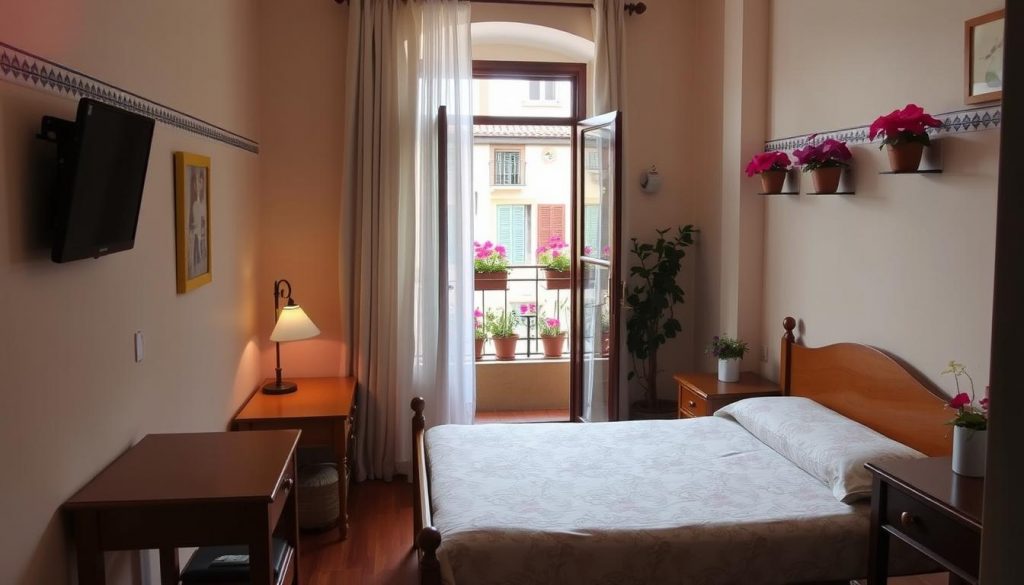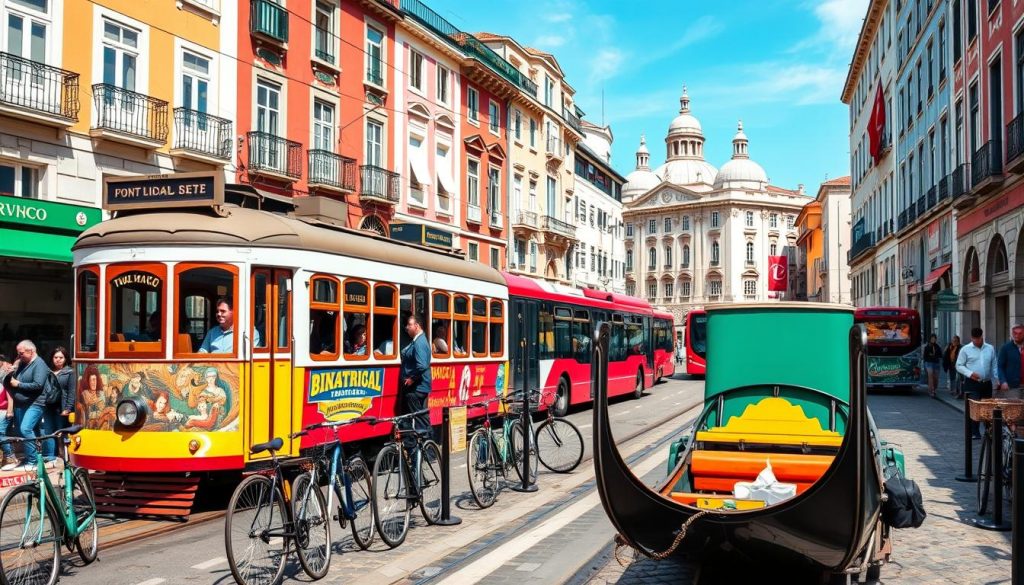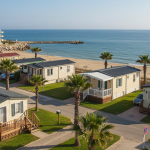
Portugal vs Italy: Which is Cheaper to Visit?
Planning a European vacation? The cost of travel is a big factor. Portugal and Italy both have rich cultures and histories. But, Portugal is 17% cheaper than Italy, according to a study. This makes Portugal a great choice for budget-conscious travelers from the US.
This article will look at the costs of staying in Portugal and Italy. We’ll compare prices for places to stay, food, transport, and attractions. By the end, you’ll know which country is the better deal for your money.
Key Takeaways
- Portugal’s overall cost of living is 17% less expensive than Italy’s.
- Renting a property in Lisbon is around 50% cheaper than in Rome for comparable locations.
- Food expenses in Portugal are generally lower than in Italy, making dining out and grocery shopping more affordable.
- Portugal ranks as the 4th safest country globally, offering a high level of security for travelers.
- Portugal provides more attainable residency visas for non-EU citizens compared to Italy.
Introduction
Portugal and Italy are both amazing places in Southern Europe. They offer history, culture, and stunning natural beauty. Portugal is known for its beautiful coastal towns, like Lisbon and Porto, and its tasty seafood. Italy is famous for its historic sites, art, and different foods from each region.
Both countries give you a great Mediterranean vibe. But, the cost of visiting them can be different. This is something to think about when you plan your trip.
Importance of Travel Costs in Destination Selection
Travel costs are key when choosing a vacation spot. You need to balance what you want to do and how much you can spend. Knowing the costs of places to stay, food, transport, and sights in Portugal and Italy helps you choose wisely.
This way, you can get the most out of your money. You’ll have a great trip and enjoy every moment.
Maybe you love Lisbon’s streets, the Amalfi Coast, or Rome’s history. The cost of your trip affects how much you’ll enjoy it. By thinking about what you can afford, you can have a trip that’s both fun and budget-friendly.
Cost of Accommodation
Accommodation costs are a big part of your travel expenses in Portugal and Italy. Portugal usually has more affordable hotel rates compared to Italy.
Average Hotel Rates in Portugal and Italy
In Rome, a four-star hotel room costs about $650 per night. A five-star hotel can cost over $1,500 per night. For luxury, expect to pay more than $2,000 per night.
A family room in Rome for four people costs under $400 per night. This makes a four-night stay in Rome cost around $1,800.
Self-catering apartments in Tuscany during high season cost between $1,500 and $3,500 per week. This totals about $2,500 for four nights.
Budget Accommodation Options in Both Countries
Both Portugal and Italy have budget-friendly places to stay. In Portugal, towns like Coimbra and Evora are cheaper but still rich in culture. Italy’s southern regions, like Naples and Palermo, also have lower costs than Rome and Milan.
For those on a tight budget, try Couchsurfing, housesitting, WWOOFing, or WorkAway. Hostels in Portugal, for example, have dorm beds for about €20. Private rooms cost between €30 and €40, especially in tourist areas.

Food and Dining Costs
Portugal is more affordable for food and dining than Italy. Eating out in Portugal is reasonable, with seafood like grilled sardines being cheap and tasty. In Italy, especially in big cities, eating out can cost more, and wine prices can add up quickly.
Cost of Eating Out
The average daily food budget in Portugal is $60 to $120. The author spent $116 per day. This includes eating at local places and sometimes treating themselves to fancier restaurants. In Italy, eating out can be pricier, with casual meals costing 15-25 EUR and fancier places 25-45 EUR or more.
Grocery Costs and Cooking at Home
Cooking your own meals can save money while traveling. Food and personal care items are cheaper in Portugal than in Italy. The author spent $170 on food for a week in Portugal, saving a lot compared to eating out.
“The dining scene in Portugal is typically quite affordable, with seafood dishes like grilled sardines or bacalhau (salt cod) being both delicious and wallet-friendly.”
Transportation Expenses

Exploring Portugal and Italy can be fun, but the cost of getting around matters. Both countries have good public transport, but prices differ.
Public Transportation Costs in Major Cities
Traveling by public transport is cheaper in Portugal than in Italy. Both countries have strong public transport systems. This lets travelers see cities and countryside without spending too much on taxis or rental cars.
- In Lisbon, a single metro or bus ticket is about €1.50. A 24-hour pass costs €6.40.
- In Porto, a single ticket is €1.20, and a 24-hour pass is €5.00.
- In Italy, like in Rome and Milan, single tickets cost between €1.50 and €2.00.
Car Rental and Fuel Prices
Having a rental car offers flexibility, but it affects your budget. Car rental and fuel costs vary in Portugal and Italy. Generally, Portugal is cheaper for living expenses, which might include transport costs too.
“Portugal is considered one of the more affordable countries in Western Europe for travelers.”
is it cheaper to visit portugal or italy
Travelers often find Portugal more affordable than Italy, especially from South Africa. Daily costs like food, lodging, and attractions are generally lower in Portugal. This makes Portugal a better choice for those watching their budget.
Breakdown of Average Daily Costs
Living costs in Portugal are about 17% lower than in Italy. Prices for food and personal care are significantly cheaper. This means average daily costs in Portugal are easier on the wallet than in Italy.
Cost Comparisons for Common Tourist Activities
Costs for tourist activities also differ between the two countries. Italy’s rich history and museums are worth the price, but can add up. Portugal, on the other hand, offers cultural experiences and festivals at a lower cost.
In conclusion, Portugal is the better choice for budget-conscious travelers. It offers a great mix of affordability and cultural richness, making it a more cost-effective option than Italy.
Attractions and Sightseeing
Exploring Portugal and Italy’s rich culture and landmarks can be costly. The entry fees for museums, historical sites, and attractions impact your budget. Knowing these costs helps plan your trip better.
Entrance Fees in Portugal
Portugal boasts medieval castles, stunning coastal towns, and impressive religious sites. Many top spots, like Lisbon’s Jerónimos Monastery and Porto’s historic center, have low or no entry fees. For example, Jerónimos Monastery costs €10 for adults, and kids under 12 get in free.
Entrance Fees in Italy
Italy is famous for its museums, galleries, and landmarks. These can increase your travel costs. The cost of attractions in italy adds up, with places like Rome’s Colosseum at €16 for adults and Florence’s Uffizi Gallery at €20. Despite higher entry fees in italy, these sites are totally worth it for many.
| Attraction | Entrance Fee in Portugal | Entrance Fee in Italy |
|---|---|---|
| Jerónimos Monastery (Lisbon) | €10 (Adults), Free (Children under 12) | N/A |
| Colosseum (Rome) | N/A | €16 (Adults), €2 (EU Citizens 18-25), Free (Children under 18) |
| Uffizi Gallery (Florence) | N/A | €20 (Adults), €4 (EU Citizens 18-25), Free (Children under 18) |
| Sé de Braga (Braga) | Free | N/A |
| Duomo di Milano (Milan) | N/A | €3 (Admission to Rooftop), €2 (Admission to Cathedral) |
Research the cost of attractions in portugal and entry fees in portugal as well as the cost of attractions in italy and entry fees in italy. This helps plan your trip and enjoy your travel experience.
Seasonal Variations
The time you choose to travel can greatly affect costs in Portugal and Italy. Both countries have lovely summers, especially in the south. But, prices for places to stay and flights vary a lot between peak and off-peak times.
High and Low Seasons
Portugal has a High Season from June to August, a Shoulder Season from September to November and April to June, and a Low Season from December to April. The warmest months in Portugal are mid-June to mid-September, with August being the hottest. Spring and fall are less crowded and cheaper, especially in Lisbon, Faro, and Porto.
Italy also has high and low seasons. July and August are the priciest months to visit, with high costs for hotels and flights. April-May and September-October are better for finding deals. Winter, from November to February, is the cheapest time to travel in Italy.
Impact on Accommodation and Flight Costs
In the high season, prices for hotels and flights go up. But, traveling in the low season can save you a lot. It’s key to know when it’s busy and when it’s not to save money.
| Season | Portugal | Italy |
|---|---|---|
| High Season | June to August | July to August |
| Shoulder Season | September to November, April to June | April to May, September to October |
| Low Season | December to April | November to February |
Knowing the seasonal changes in Portugal and Italy helps you plan better. You can save on places to stay and flights by choosing the right time to visit.
Budgeting Tips
Traveling to Portugal or Italy on a budget is easy with some planning. You can find budget accommodations in Portugal and saving on hotels in Italy. Also, there are ways to enjoy affordable dining in both countries.
Maximize Your Accommodation Savings
To save on budget accommodations in Portugal, look at places like Coimbra or Evora. They are cheaper than the usual tourist spots. In Italy, the south, like Naples and Palermo, is also more affordable than the north.
Enjoy Affordable Dining and Transportation
Dining in Portugal is affordable, with tasty options like grilled sardines and bacalhau. You can also use budget-friendly transportation in Portugal like buses and trams. This way, you can see the country without spending too much.
In Italy, you’ll find affordable dining and good public transport. This helps you save money while traveling.
“Traveling on a budget in Portugal can involve exploring free activities, using local transportation like buses and trams, and taking advantage of free walking tours in major cities.”
With these tips, you can enjoy Portugal and Italy without spending a lot. Whether you’re looking for budget accommodations in Italy or affordable dining in Portugal, these suggestions will make your trip memorable and budget-friendly.
Cultural Experiences
Portugal and Italy are known for their rich culture. They offer a world of history, art, and traditions. You can enjoy everything from Venice’s vibrant carnivals to Lisbon’s soulful fado music.
Cost of Attending Local Events and Festivals
Exploring local events and festivals is a great way to dive into Portugal and Italy’s culture. In Portugal, you can experience the Festa dos Tabuleiros in Tomar, the Festa de São João in Porto, and the Carnaval de Ovar. These celebrations feature traditional music, dance, and food. Admission prices vary, but many events are free or low-cost.
In Italy, you’ll find festivals like the Carnevale di Venezia, the Palio di Siena horse race, and the Sagra delle Sagre food festival in Asti. While some events may cost more, many festivals offer free or low-cost entry. This lets you dive into Italy’s culture without spending a lot.
| Event/Festival | Location | Typical Cost |
|---|---|---|
| Festa dos Tabuleiros | Tomar, Portugal | Free admission |
| Festa de São João | Porto, Portugal | Free admission |
| Carnaval de Ovar | Ovar, Portugal | Free admission |
| Carnevale di Venezia | Venice, Italy | €20-€150 for ticketed events |
| Palio di Siena | Siena, Italy | €10-€30 for grandstand seating |
| Sagra delle Sagre | Asti, Italy | Free admission |
By exploring the cultural activities and festivals in Portugal and Italy, you can appreciate their rich heritage. And you can do it without spending a lot.
Hidden Costs
Planning a trip to Portugal or Italy means knowing about hidden expenses. Accommodation and dining costs are clear, but there are extra fees to consider. These can affect your budget.
Unexpected Expenses to Consider
Tourist taxes are a common hidden cost. Cities with lots of tourists charge a tax per person, per night. This tax can be a few euros or more than €5, adding up fast. Knowing the local tax policies ahead of time helps.
Dynamic pricing is another hidden expense. Prices for flights, trains, and hotels change based on demand and season. Booking last minute or during peak times can lead to higher costs.
Also, watch out for additional fees for activities or services. Entrance fees for museums, guided tours, or parking can add up. Reading the fine print and researching local costs helps avoid these hidden expenses in Portugal or hidden expenses in Italy.
Knowing about these unexpected costs in Portugal and unexpected costs in Italy helps plan better. This way, you can enjoy your trip without worrying about money.
Conclusion
Both Portugal and Italy offer unique travel experiences. But, Portugal is generally cheaper. It has lower prices for places to stay, food, transport, and attractions.
Italy’s culture, food, and views are amazing. But, the cost might stop some people. The choice between Portugal and Italy depends on what you want and can afford. By looking at Portugal vs Italy travel costs, you can choose wisely and have a great trip.
Looking for a sunny, affordable trip or Italy’s art and food? Knowing the cost differences helps you plan better. It ensures you get the most out of your travel and budget.
FAQ
Is it cheaper to visit Portugal or Italy?
Portugal is often cheaper than Italy. You’ll find lower prices for places to stay, food, travel, and things to do. This makes Portugal a great choice for those watching their budget.
What are the key cost differences between Portugal and Italy?
Hotels and rentals are cheaper in Portugal than in Italy. Eating out and everyday costs are also lower in Portugal. This makes Portugal a more affordable option.
How do the transportation expenses compare between Portugal and Italy?
Both countries have good public transport, but Portugal is more affordable. Car rentals and fuel are also cheaper in Portugal.
What are some budget-friendly accommodation options in Portugal and Italy?
In Portugal, try Coimbra or Evora for affordable living and culture. In Italy, Naples and Palermo are cheaper than the north.
How can travelers save on dining costs in Portugal and Italy?
Portugal’s seafood and traditional dishes are tasty and cheap. Cooking at your place can save money in both countries.
What are some tips for saving money when visiting Portugal and Italy?
Visit off-the-beaten-path places, use public transport, and cook your meals. Also, look for free or cheap cultural events in both countries.
How does the seasonality affect the cost of travel in Portugal and Italy?
Prices for places to stay and flights change with the seasons. Traveling in the off-peak can save you a lot of money.
What are some potential hidden costs to consider when visiting Portugal and Italy?
Watch out for tourist taxes, changing prices, and extra fees for activities. These costs might not be obvious at first.



